#monsieur verdoux: a comedy of murders
Photo
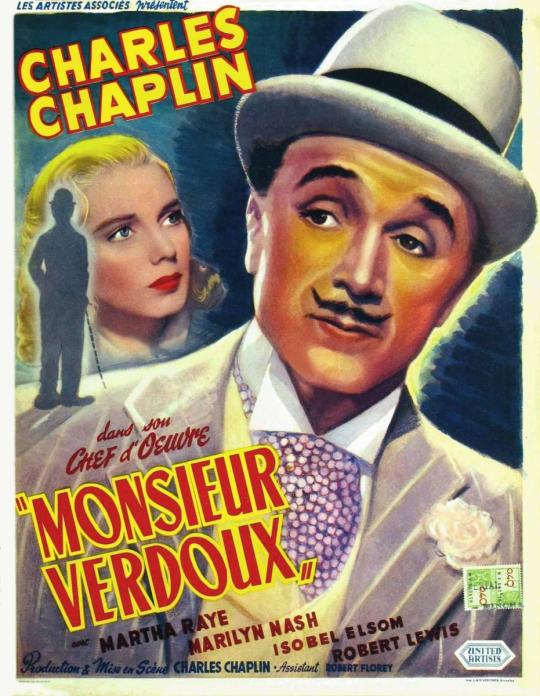

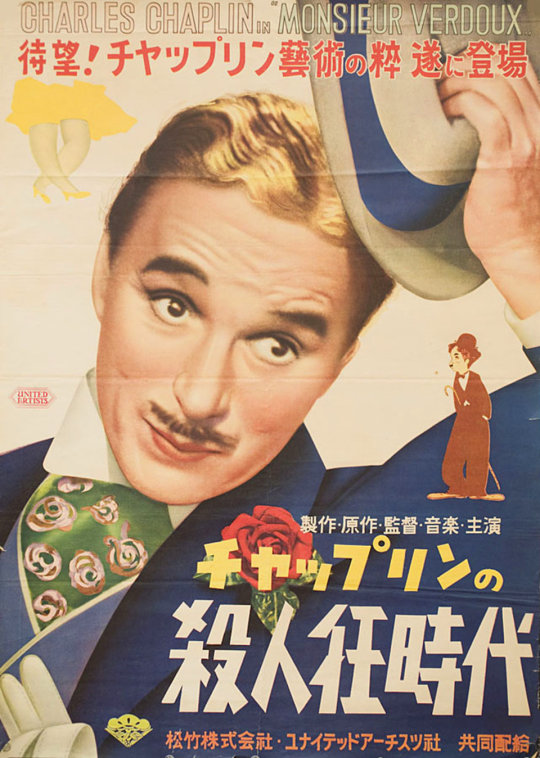

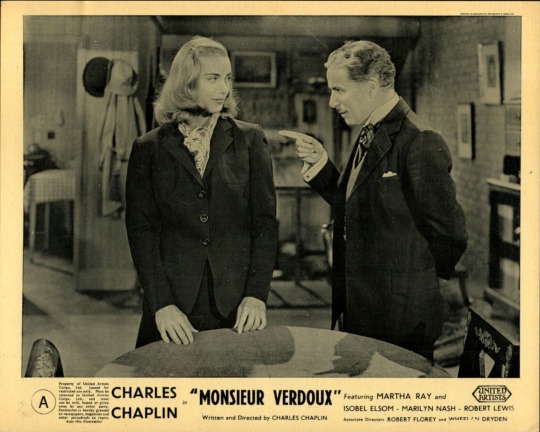
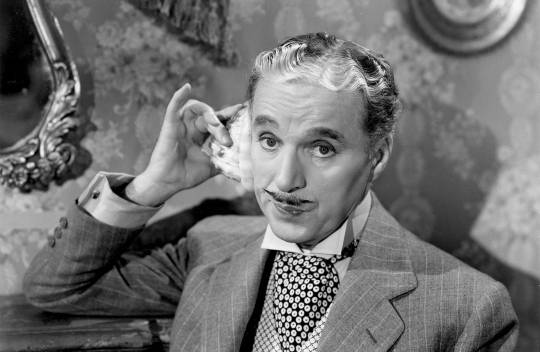

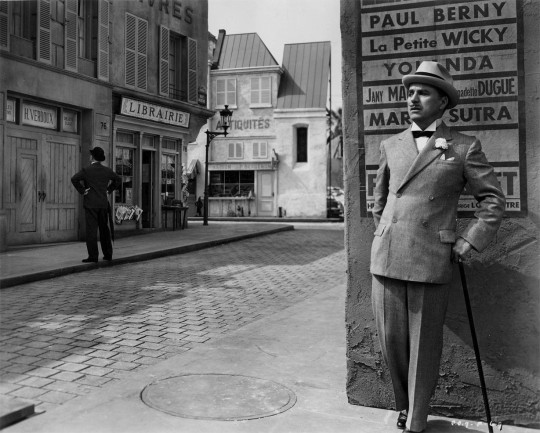


Monsieur Verdoux (1947) Charlie Chaplin
January 2nd 2023
#monsieur verdoux#1947#charlie chaplin#martha raye#marilyn nash#isobel elsom#marjorie bennett#mady correll#robert lewis#margaret hoffman#almira sessions#edwin mills#lois conklin#edna purviance#orson welles#a comedy of murders#the ladykiller#monsieur verdoux: a comedy of murders
38 notes
·
View notes
Photo

Michel Simon and Germaine Reuver in La Poison (Sacha Guitry, 1951)
Cast: Michel Simon, Jean Debucourt, Jacques Varennes, Jeanne Fusier-Gir, Germaine Reuver, Pauline Carton, Albert Duvaleix, Georges Bever. Screenplay: Sacha Guitry. Cinematography: Jean Bachelet. Production design: Robert Dumesnil. Film editing: Raymond Lamy. Music: Louiguy.
I thought there was something off about the title of Sacha Guitry's La Poison, and I was right: The French word for substances like arsenic and strychnine is masculine -- le poison. When the word becomes feminine, la poison, it can be roughly translated as "pest" or "nuisance." Exploring the psychology behind the genders assigned to words in languages that have such inflections is dangerous, but it seems somehow in keeping with what some have called the film's "misogyny" that the feminine form of the word should take on such connotations. La Poison is a dark comedy about wife-killing, somewhat reminiscent of Charles Chaplin's Monsieur Verdoux (1947), though without Chaplin's sentimentality and tendency to moralize. The great Michel Simon, who is lionized in Guitry's extended opening credits sequence, plays Paul Braconnier, married to a slatternly drunkard, Blandine. She hates him as much as he does her, and is in fact the first to put in motion an attempt to do away with him when she buys a supply of rat poison. Eventually, however, he gets the upper hand (which holds a knife). But the film is most centrally about the justice system, in which sharp lawyers like the defense attorney Aubanel (Jean Debucourt) are able to help the guilty escape the guillotine. Braconnier hears Aubanel on the radio, talking about how he has just achieved his hundredth acquittal, so Braconnier goes to see him, pretending that he has just murdered his wife, when in fact he's really there to figure out the safest way to do it. Shrewdly, Braconnier tricks the attorney into pointing him in the direction of the best ways to murder someone -- by, for example, staging it to look like self-defense and to avoid any hints of premeditation. So Braconnier goes back to his village and does Blandine in, then recruits Aubanel for the defense. The lawyer is indignant at being so used, but Braconnier has the goods on him as an unwitting accomplice in the crime. He stands trial and is acquitted. Guitry has learned a lot about filmmaking since his movies of the 1930s, which were often more static and talky than was good for them, and there's a crispness and fluidity to La Poison that's admirable. Simon is at his best in the trial scene, but there's a sourness to the concept that keeps the film from being entirely enjoyable. Critics and scholars of Guitry's work have pointed out that it's a bit of revenge flick, its hits at the judicial system expressive of Guitry's resentment at having been interned as a collaborator after World War II, when in fact he was always anti-Nazi and even helped some Jewish friends escape.
2 notes
·
View notes
Photo
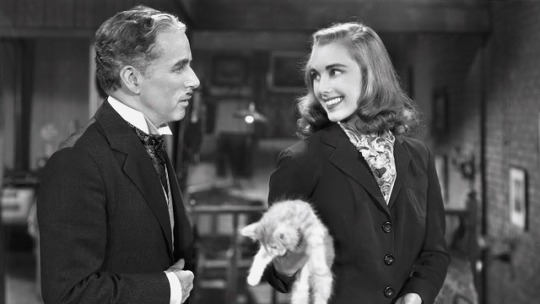
#1947#monsieur verdoux#charlie chaplin#marilyn nash#film still#dark comedy#happy birthday charlie#a comedy of murders
37 notes
·
View notes
Photo

Style is knowing who you are, what you want to say, and not giving a damn.
- Orson Welles
It is an odd fact that two of the most original film artists in Hollywood only ever collaborated once in their stellar careers. Both Orson Welles and Charlie Chaplin made their mark by the time they reached 26 years old. But both would be driven out of Hollywood for very different reasons.
Monsieur Verdoux (1947) was the one film both iconic film makers did work together on. Charlie Chaplin said, without false modesty, that Monsieur Verdoux was "the most intelligent and brilliant film of his entire career".
It is in any case the darkest of his comedies: the story of a serial killer who ends up on the guillotine. But, as Chaplin always said, comedy is never far from tragedy and horror. "Under the right circumstances, murder can be comic," he wrote.
The original idea was suggested by Orson Welles. It was originally a project for a dramatic documentary about the legendary French assassin Henri-Désiré Landru, who was executed in 1922 after killing at least ten women, two dogs and a young boy. Chaplin paid Welles $5,000 for the idea, agreeing that the credits should read, "Inspired by an idea of Orson Welles." Later, Welles would claim that he had written a script for the film himself, but this is unlikely. In any case, the written agreement between Chaplin and Welles makes no mention of this.
The agreement was signed in 1941, but it took Chaplin four years to complete the script. In the meantime, he was distracted from his work by a painful paternity suit, which was offset by his happy marriage to Oona O'Neill.
Chaplin claimed that the character of Verdoux was partly inspired by Thomas Wainwright, a nineteenth-century English forger, murderer and intellectual.
Monsieur Verdoux was released in New York in April 1947, at a time when political paranoia was reaching its peak. Chaplin, vaguely suspected of extremist sympathies by J. Edgar Hoover of the powerful FBI, was one of its most notable victims.
Already affected by the general unfavourable reaction to the film premiere, he was even more so by a press conference where hostile journalists refused to talk about the film but asked him pointedly about his political views, his patriotism, his tax problems and his refusal to adopt American nationality.
September 1952 marked Charlie Chaplin's first visit to England in 21 years; yet it also marked the beginning of his exile from the United States. The trip to Europe was meant to be a brief one to promote his new film Limelight, with Chaplin remarking upon his departure that "I shall probably be away for six months, but no more." However, on 19 September, while Chaplin was still at sea, the US Attorney-General announced plans to lauch an inquiry into whether he would be re-admitted to the US. In the end it would be 20 years before he would return.
For Orson Welles, he would spend the rest of his life trying to make films on his own terms after the critical success of Citizen Kane. Welles was willing and eager to work, virtually to the last day of his life. The fundamental sources of his difficulties remained what they had been throughout his career: the financial and artistic constraints bound up with working in the American film industry.
In effect Welles was blacklisted by the Hollywood studios in the late 1940s. McBride points to “unmistakable evidence, hidden in plain sight, that Welles’s political and cultural activities had caused him to be blacklisted during the postwar era. His decision to leave the country in 1947, just as the Hollywood blacklist was being imposed, and his reinvention of himself as a wandering European filmmaker, largely out of necessity, hastened his already strong bent toward independence from the commercial system.
**Photo: Orson Welles and Charlie Chaplin having a lunch together at the Brown Derby in Hollywood, 1947.
126 notes
·
View notes
Text
April 5, 2021: Arsenic and Old Lace (1944) (Recap: Part One)
Yeah, so...Spectrum exploded last night.
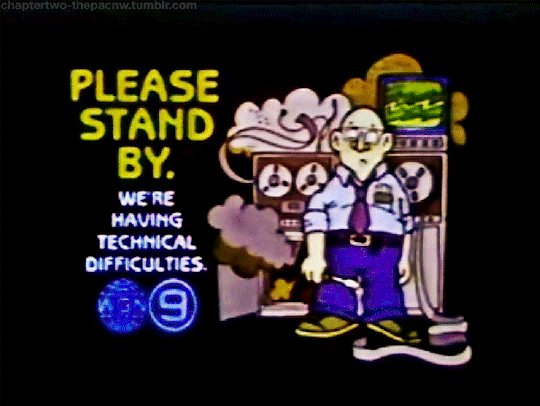
So, I'm unfortunately a little behind. BUT NEVER FEAR! I'll get back on time before you know it! So, uh...where were we last time? OH RIGHT! Let's talk about black comedy. And I don't mean black-and-white comedies, or comedies prominently featuring African-American culture and demographic. No, I mean dark comedies.

The "black comedy" functions off of macabre or taboo humor and jokes, and is often closely associated with biting satire and commentary in film. That definition is loose as hell, I know, but it's all about the subject matter. The most common subject matter for dark humor is death, of course, and related subjects to death. War, murder, strife, madness, and violence are also common topics here.
Some of the best comedies are black comedies, though. For example, Brazil (1985; dir. Terry Gilliam) focuses on themes of depression, dreams, terrorism, totalitarian governments, and madness. And it's GREAT. How about The Death of Stalin (2018; dir. Armando Iannucci)? The title ALONE should tell you everything you need to know about the tone and topic, AND YET...

It's HILARIOUS. And also informative! If you haven't seen it, I definitely recommend it. And again, that film is about, well...the death of Stalin, and the fallout of his disastrous and murderous regime. Dark, DARK topic, but very funny movie.
Dr. Strangelove, or How I Learned to Stop Worrying and Love the Bomb is about war; Fargo is about murder in North Dakota; Heathers is about a toxic relationship and the death and murder of teenagers; Birdman, or The Unexpected Virtue of Ignorance is about an actor's existential crisis and complete mental breakdown; and Trainspotting is about the devastating effects of drug addiction and features a DEAD BABY FOR CHRIST'S SAKE...and yet they're all full of laughs! Except for the baby scene. Fuck me, the baby scene in Trainspotting.

So, yeah, these are a diverse group of films, that's for sure. But where does it all start? There's 1942's To Be or Not to Be (dir. Ernst Lubitsch), which is about a Polish theatre company who need to escape in the midst of...well, 1942 Poland. If you don't get why that's dark, you should probably look up some history, bud. Charlie Chaplin would dip into the role in 1947's Monsieur Verdoux, which I mentioned last time. And there's the seldom-talked-about Kind Hearts and Coronets (dir. Robert Hamer), a 1949 film about murder for status, essentially.
But it's hard to argue that the most prominent early black comedy is 1944's Cary Grant vehicle, Arsenic and Old Lace.

Directed by Frank Capra, this film was based on a 1941 stage play, and is about...well, we'll get to it. While its prominence as a black comedy is one reason I'm watching this movie, the other is...well, to be honest, this is a movie I heard about CONSTANTLY from my Mom, as this is one of her favorites. And yet, like Dirty Dancing, I've somehow never seen it! Let's remedy that.
So, without further ado, let's get into it! SPOILERS AHEAD!!!
Recap (1/2)

The film starts off with a BANG, as a man calls me a “big simp” to my face! Actually, he’s screaming at a Brooklyn Dodgers game, where a massive fight breaks out. This fight quickly transitions to a city hall, where a line of people are waiting to file marriage licenses. Amongst the line is Mortimer Brewster (Cary Grant) and Elaine Harper (Priscilla Lane).
Brewster is hiding from the press, as he’s a famous reviewer, and author of the Bachelor’s Bible, and it would be quite the scandal for him to get married. And yet, he’s head over heels in love with Elaine. After going through an existential crisis about the whole thing, he gives into Elaine’s sweet demeanor, and the two file their marriage license officially.
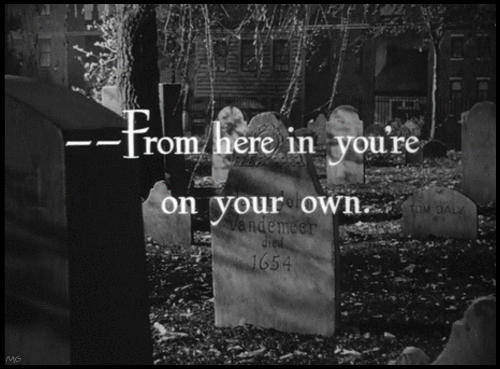
It’s Halloween day, and we move from the city to the suburbs of Brooklyn, where two policemen, O’Hara (Jack Carson) and Sanders (John RIdgely) are on patrol. Sanders tells O’Hara of the kindly Brewster Sisters, the sweetest women on Earth, both of whom live in the neighborhood. Currently, they are being visited by Reverend Harper (Grant Mitchell), Elaine’s father. He’s speaking with Abby (Josephine Hull) and Martha Brewster (Jean Adair), the kindly aunts of Mortimer.
Also living there is Mortimer’s brother Teddy Brewster (John Alexander), who apparently believes that he’s Teddy Roosevelt, which is...hilarious. Dude is hilarious, seriously. The cops come over to visit the two, and collect some clothes and toys for local charity. Also, Teddy only leaves a room by screaming “CHAAAAARGE!!!”, and running up the stairs, and I love Teddy a lot.
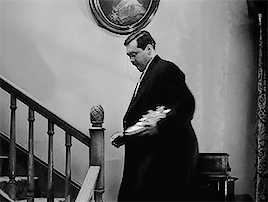
Reverend Harper and the cops leave for the night, and the sisters settle down for the evening. Abby and Martha state that their plans for Elaine and Mortimer should go as scheduled, which is probably talking about their marriage. Abby also mentions that she’s done something while she was away, to Martha’s delight and surprise. They tell Teddy that he’ll soon be digging a new lock for the Panama Canal...whatever that means.
Martha’s about to go to the basement to see what Abby’s done, but she states that because she was all by herself, the surprise is in the window seat. As she’s about to look at the surprise, Elaine shows up in the window, and the two arrive to give the happy news that they’re married. Elaine goes to tell her father of the news, while Mortimer goes to tell his sweet aunts. Afterwards, the two will be on their honeymoon, going to Niagara Falls. And I should say, they’re quite a sweet couple.

After telling the news to his aunts, he asks them where his notes are for his new controversial book, Mind Over Matrimony. They go to look for it around the house, and Teddy comes downstairs, dressed up in attire to “go to Panama.” Aunt Abby comes across a childhood picture of Jonathan, Mortimer’s brother and apparently a violent sociopath or some sort. She goes to burn the picture (geez), and Mortimer continues to look for the notes. He goes to the window seat.

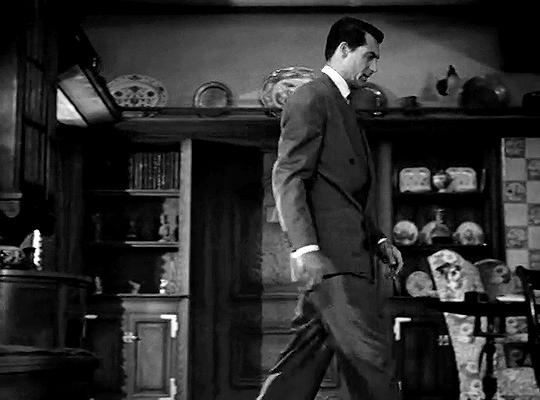

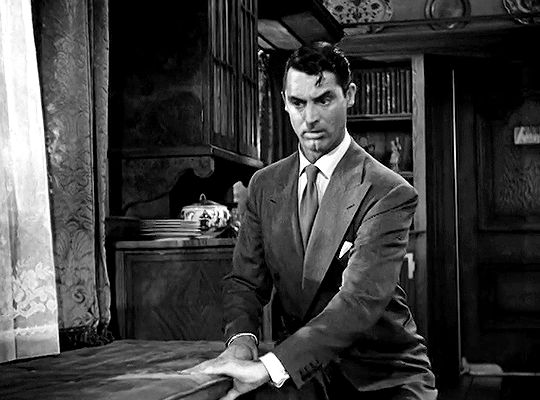
Yup! It’s a body! Looks like Abby and Martha’s sweet old lady act is a guise for some myurder! Which I know, just because it’s the most famous thing about the movie. However, Mortimer thinks the murderer is Teddy, and tells his sweet old aunts about the body, asking that he gets put into an asylum. But Abby notes that Teddy didn’t kill the man, and they already know about the body!
Which, yeah, surprises Mortimer, obviously.

Abby cheerfully admits that the man, Mr. Hoskins, was poisoned by a tainted glass of elderberry wine, and that they did so on purpose, hiding the body before the Reverend came for a visit. The whole thing isn’t a big deal; it’s just Abby and Martha’s little secret!
After they leave, and brush off the whole thing as easy as needlepoint or macramé as a hobby, Mortimer, is completely broken by the whole affair, and is partially convinced that he’s dreaming. All the while, Elaine’s trying to get Mortimer to come over and speak with her father. But Mortimer can’t exactly forget about this whole silly murder thing, and goes to confront his aunts about it. He learns that Teddy’s digging not a lock, but a grave in the cellar. As he’s done with 10 other bodies. Or maybe it’s 11 others?

After picking up a phone call from Elaine, then hanging up abruptly (and understandably), Mortimer finds out how this whole thing started. See, the two have a “Renters Wanted” sign in their front lawn, and the neighborhood thinks that it’s there so the two sweet old ladies can offer help to anyone in need, even though they aren’t actually renting to anyone. In reality...well, they do it for another reason.
See, an older gentleman stopped by a bit ago, and he had a heart attack right there in the living room. After seeing how peaceful he looked, the two decided to bring in other lonely old men and bring in the same kind of peace. And from there...well, yeah, you get the general idea. They’ve been poisoning them with arsenic, strychnine, and cyanide mixed in with elderberry wine. Apparently, Martha’s got the mixture just right so that it tastes delicious. With all this explained, they offer Mortimer a sip of wine. Which he’s understandably nervous about.

But with all of that done, Elaine comes over to check in on him. But he’s not able to tell her anything, which greatly (and understandably) confuses her. He basically kicks her out (which enrages her, once again understandably), and calls a judge with the intent to frame the whole affair on Teddy, who’s always been.unstable. Which, for the record, is not even SLIGHTLY going to solve the problem.
But as he’s on the phone, a man named Gibbs (Edward McWade) comes in to rent an apartment. He’s all alone in the world, with nobody to care for him. And of course, this leads to the women trying to poison him with the wine. It’s a funny yet tense moment as he stops just short of drinking the wine, distracted by Mortimer’s freakout over the phone. But Mortimer gets off the phone JUST in time to scare Gibbs away and stop him from drinking the wine. And it is...VERY funny, goddamn.

As Mortimer tries to tell the aunts exactly what’s wrong with what they’re doing, the phone rings. It’s a call from Witherspoon (Edward Everett Horton), who runs an asylum that Mortimer wants Teddy committed into. However, they don’t quite have room for him, as they have too many Theodore Roosevelts at present. However, they do need more Napoleon Bonapartes. I love this goddamn movie.
Still, Witherspoon agrees to take him in despite that, and Mortimer head out to get the paperwork done. However, he asks his aunts to not do anything until he gets back, and he also proises that he’ll attend the “services” for their latest victim. He leaves, and kinda steals a cabbie’s car in the process (I love this movie, I’m telling you), and Abby and Martha start shutting things down for the night. However, as they do, they get a mysterious knock on the door. They pretend not to be home...only for a man with an ominous scar to enter the room regardless.

Let’s pause here, shall we? See you in Part 2!
#arsenic and old lace#frank capra#joseph kesselring#cary grant#priscilla lane#raymond massey#jack carson#peter lorre#jean adait#josephine hull#john alexander#john ridgely#userveil#johnsonshildy#userkeanu#usersasha#user365#comedy april#365days365movies#365 movie challenge#365 movies 365 days#365 Days 365 Movies#365 movies a year
19 notes
·
View notes
Photo


Charlie Chaplin & Orson Welles - 1942.
Telegram - Orson Welles thoughts on Chaplin, written on the back of a telegram from the Ritz Hotel:
“Charlot belongs to that grand horizon of the world imagination where stand the silhouettes of Quixote, Pantagruel, Pickwick, Puck and Punchinello…As a Film-Creator Chaplin has made his medium something more valid than an art.”
Some may not know Orson Welles originally wanted to do a film on French serial killer Henri Landru with Charlie as the lead. Charlie not one to be directed by others paid Orson Welles $5000.00 (about $70 thousand in 2019) for the idea and a screen credit for just that, out of that came “Monsieur Verdoux”
1947 - “Charles Chaplin in “Monsieur Verdoux” A Comedy of Murders”
“An Original Story written by Charles Chaplin
Based on an idea by Orsen Welles”
36 notes
·
View notes
Photo
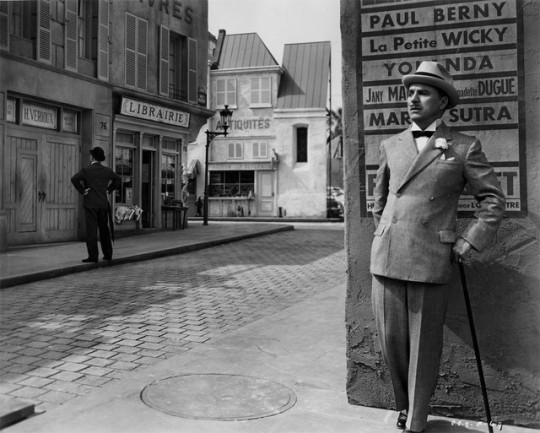
Monsieur Verdoux (1947). This darkest of comedies is based on the life of French serial killer Henri Désiré Landru, who was guillotined in 1922 having murdered 10 women, one child and two dogs. At its heart is the message that the actions of even one such despicable individual are tame compared to the state-sponsored evils of war and weapons of mass destruction – which of course led to calls for his deportation.
Congressman John E. Rankin of Mississippi stated: “His very life in Hollywood is detrimental to the moral fabric of America... his loathsome pictures [should] be kept from before the eyes of the American youth. He should be deported and gotten rid of at once."
The media backlash ensured that the film bombed in the US, but it fared much better overseas.
Daily inspiration. Discover more photos at http://justforbooks.tumblr.com
8 notes
·
View notes
Text
On This Day...

On this day in 1952, legendary actor Charlie Chaplin, who had departed New York for London with his family aboard the RMS Queen Elizabeth the day before, publicly had his re-entry permit to the United States revoked by Attorney General James P. McGranery. Chaplin, a British citizen, had built virtually his entire career to that point in the United States, but a series of scandals and innuendos that he was a member of the Communist Party tainted his reputation. For the next two decades, Chaplin lived in Switzerland, having severed all ties to the United States.
Charlie Chaplin became one of the film industry’s first great superstars in the 1920s and 1930s. During this time, Chaplin made a number of silent films which are still considered among the hundred best movies ever made. In 1940, Chaplin crowned his career with the release of his first sound film, The Great Dictator. Considering the time in which it was made, The Great Dictator remains today an astonishingly profound indictment of fascism and nationalism when the horrors of both were barely apparent to the rest of the world. The satire was a critical success, and was also Chaplin’s most commercially successful film. Chaplin’s career was at its zenith.
In 1941-42, Chaplin had a brief affair with actress Joan Barry. The dalliance became public knowledge in the months after Chaplin ended the relationship, when Barry began stalking Chaplin, leading to her being arrested twice. Around the same time, Barry announced she was pregnant and filed a paternity suit against Chaplin, who insisted the child was not his. After two trials, in which much of Chaplin’s personal life was put into public record leading to many frenzied gossip columns, Chaplin was determined by the court to be the father of Barry’s daughter. He was ordered to financially support the child until her 21st birthday. The torrid nature of the proceedings amplified when FBI Director J. Edgar Hoover, who disliked Chaplin, took advantage of the paternity suit and announced that the FBI was investigating Chaplin for alleged violations of the Mann Act. Hoover’s allegation was that Chaplin had impregnated Barry after transporting her across state lines, essentially charging him with sex trafficking. There was scant evidence to support the charge and the jury acquitted Chaplin in that regard. Chaplin’s reputation, however, was badly scarred. Chaplin exacerbated the entire situation still further when, at the age of 54, he married his 18 year protege, Oona O’Neil. The once-highly praised actor was now thought of as a lecherous old man.
The end of World War II led to a rapid deterioration in relations between the United States and the Soviet Union. The erstwhile wartime allies grew suspicious of the each other’s geopolitical intentions and abilities. This period, which I’ve written about before, is called the Red Scare, and lasted much of the 1940s and 50s. During this time, thousands of American citizens were investigated by the FBI for any statements or actions that appeared to show a connection to communism, the Soviet Union, or any other “progressive” ideas. The House Un-American Activities Committee and Senator Joe McCarthy saw themselves as the scourge of anyone who, in their eyes, participated in movements that sought to undermine the capitalist society of the west.
It was in this climate that Charlie Chaplin released his first post-war film, Monsieur Verdoux. The film marked the first time Chaplin did not feature in his role of The Tramp. Instead, it was a black comedy about a poor French bank teller who supports a lavish lifestyle by marrying women of means and then murdering them. The film was taken as a criticism of western values and of the capitalist system. Chaplin said as much and this, along with previous statements criticizing national policies which lead to war, brought him to the attention of J. Edgar Hoover’s FBI again. Monsieur Verdoux received somewhat muted critical praise and was a domestic box office bust because it was deemed anti-American. While he was despondent over the film’s failure, he refused to disassociate himself from its message, calling it the “most clever film I ever made.”
With his reputation still sullied by the Joan Barry affair, Chaplin’s apparent association with anti-western ideals further undermined his career. Chaplin was even briefly investigated by the House Un-American Activities Committee, though he was never called to testify. Throughout the late 1940s, the FBI continued to investigate Chaplin, intending to seize on any opportunity to have him deported. For his part, Chaplin denied he was a communist, but refused to cooperate with either HUAC or the FBI, declaring that their actions trampled on civil liberties.
In 1952, Chaplin’s studio released his next film, Limelight. The film focused on a once popular vaudeville actor coming to terms with his fading popularity. Though it was filmed entirely in Hollywood, it was set in London. Because of this, Chaplin decided to hold the premiere across the Atlantic, in his native Britain. Though Chaplin had lived in the United States for four decades, and his wife Oona was an American citizen, he personally never sought citizenship. Upon leaving the country, he would have to apply for re-entry with immigration officials. Realizing the opportunity, the Attorney General, at Hoover’s urging, declared on September 19, the day after Chaplin departed New York City, that any application for reentry would be denied. This decision was allegedly supported by evidence of communist collusion in Chaplin’s FBI file, though this assertion is now known to be false and no such evidence exists.
Chaplin accepted the circumstances and moved with his family to Switzerland. His wife, Oona, renounced her American citizenship and become a British citizen. Chaplin closed his studio, liquidated his American estate, and sold his share in United Artists studios. Chaplin would not step foot in the United States for two decades. In 1972, he was invited to Hollywood to receive an honorary Academy Award. Chaplin reluctantly agreed. When he stepped on the stage at the Academy Awards on April 10, 1972, Chaplin received a 12-minute standing ovation, his reputation as one of the American film industry’s finest actors and producers completely resurrected.
youtube
#On This Day#RTARLAD#history#film#movies#Hollywood#Charlie Chaplin#acting#World War II#Red Scare#HUAC#Joe McCarthy#McCarthyism#communism#Soviet Union#Switzerland#Oona O'Neil#The Great Dictator#entertainment#Academy Awards#Oscars#FBI#J. Edgar Hoover
0 notes
Text
MONSIEUR VERDOUX (1947)
This is a powerful grime comedy, one of Chaplin’s finest. Set in pre-war France, it is the story of a bank clerk who, losing his position after 35 years, marries and murders rich widows in order to support his family. With information provided by a chemist friend, he develops a poison that proves to be undetectable. His attempt to prove this failed---a young woman he picks up in the rain and offers a meal to talks about love and beauty in the world which convinces Verdoux to not try the poison out on her. She leaves thinking Verdoux is a rather kind gentleman. The poison is proven to work, though, when Verdoux gets an arresting officer to drink some. Police eventually catch up with Verdoux and he is convicted of murder. His speach at the end of the trial is a strong statement denouncing war: https://www.youtube.com/watch?v=bpwye2H9tBQ
Chaplin’s Verdoux is far from his traditional tramp, although there are moments of physical humour that are uniquely his. There is an odd intimacy in the movie that is more common in live theatre than film. Except for the scene where he shows compassion for a young woman, there is little likeable about Verdoux. One is drawn into his the webs he has woven, but rarely empathises with him even when the scenes are wonderfully funny. Well worth repeated viewings.
0 notes
Text
Diversion assumes a critical part in a comedy
ctn comedy 2017 new this week Diversion assumes a critical part in a comedy movies which for the most part has a cheerful completion except for dark comedy. Comedy is one of the most established sorts in film with the main noiseless motion picture being a comedy. Comedy lays accentuation on individual entertainers, with various stand-up humorists swinging to movies because of their ubiquity.
Comedy movies have an exceptionally happy script with the sole motivation behind engaging. However other comedy movies convey a social or political message like sway the pooch and man of the year.
William Shakespeare's Much Ado about Nothing is thought to be the primary comedy of conduct, however the class really wound up plainly conspicuous amid the Restoration time frame. The plot of the comedy comprises of an illegal issue or some other contention or prattle. The witty exchanges of the comedy is more essential than the story.
In a specific sort of comedy the fundamental character or characters wind up going up against a strange circumstance which causes silliness. Such circumstances may emerge for instance with the trading of sexual orientation parts as in Tootsie (1982); changing age part, as in Big (1988); an individual getting a charge out of opportunity set in an organized environment as in Police Academy (1984).
A farce or satire is a comedy film that utilizations mockery, generalization and sneering of scenes from different movies. Bursting Saddles (1974), Airplane! (1980) and Young Frankenstein (1974) are cases in this classification.
The anarchic comedy film utilizes futile and silly, continuous flow silliness which frequently mocks some sort of expert. These sorts of movies have begun from a showy history of anarchic organized comedy. Unmistakable movies in this class incorporates Duck Soup (1933), National Lampoon's Animal House (1978), Monty Python and the Holy Grail (1975).
Dark comedy movies mocks demise, murder, suicide and war which are typically thought to be the precluded subjects. Cases incorporate Arsenic and Old Lace (1944), Monsieur Verdoux (1947), Kind Hearts and Coronets (1949), The Ladykillers (1955).
Net out movies are of late starting point and manages sex and latrine amusingness. There's Something About Mary (1998), and American Pie (1999) are cases in this classification.
The rom-com rotates around the connection amongst man and lady. The carefree rom-coms normally demonstrates social associations and sexual pressures between the couple. Cases of this sort of film incorporate It's a Wonderful World (1939), The Shop Around the Corner (1940), Sabrina (1954), When Harry Met Sally... (1989), Pretty Woman (1990).
0 notes
Photo

#1947#monsieur verdoux#charlie chaplin#martha raye#film still#dark comedy#a comedy of murders#happy birthday charlie
36 notes
·
View notes
Photo

#1947#charlie chaplin#monsieur verdoux#film still#happy birthday charlie#a comedy of murders#dark comedy
21 notes
·
View notes
Photo

#1947#monsieur verdoux#charlie chaplin#film still#happy birthday charlie#dark comedy#a comedy of murders
11 notes
·
View notes